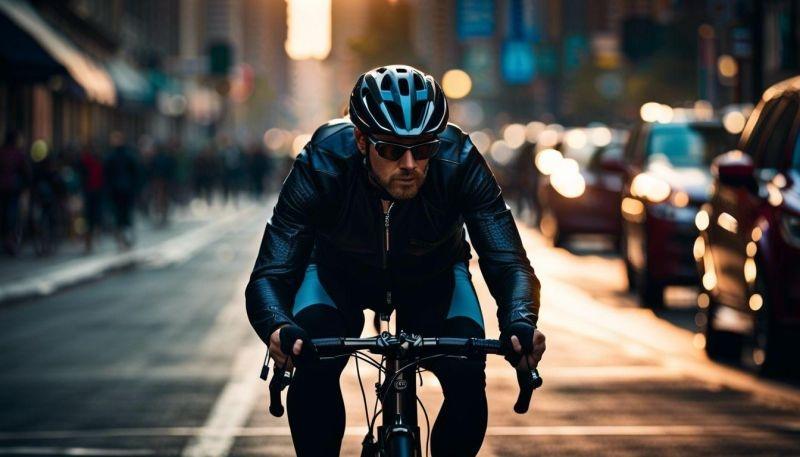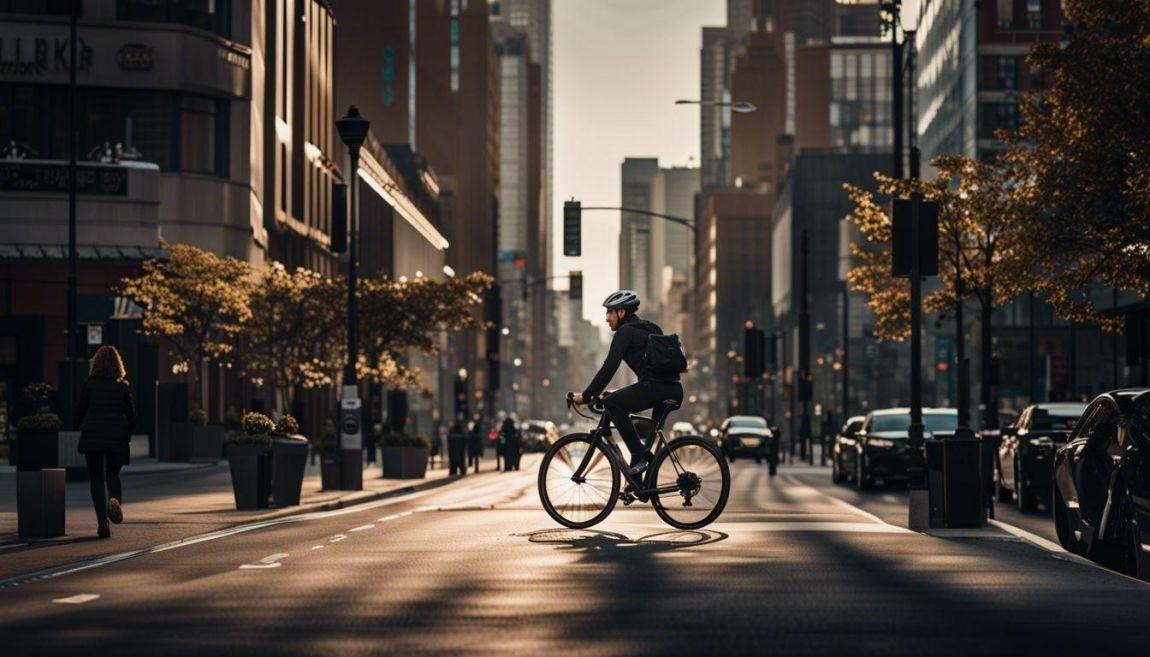Are you tired of traffic jams and parking hassles on your way to work? Well, bike commuting is not only a healthier alternative but also an enjoyable one. This post provides practical tips on making your ride safer and easier, from choosing the right gear to taking the safest route.
Let's pedal for a better commute!
Key Takeaways
- Choosing the right bike and gear is essential for a safe and enjoyable bike commute.
- Planning and practicing your route in advance can help you avoid getting lost or taking detours, making your commute more efficient.
- Obeying traffic laws, communicating with drivers, and being visible on the road are crucial for ensuring safety during your bike commute.

Choosing the Right Bike and Gear
Choosing the right bike for your commute is essential to make your ride safer and more enjoyable. Urban mobility is something that we love to see as a trend that helps use reduce the number of cars on city streets as well as makes it easier and quicker to get to work. While there are many advantages of using electric devices to speed you to your destination quickly - such as a Onewheel, an electric scooter, or a e-Bike - the classic bicycle remains a top choice for most commuters.
Get the right bike for the job
Selecting the optimal bike for your daily commute is just as crucial as planning your route. The first step involves determining what you're looking for in a bicycle, which relies heavily on individual preferences and needs.
If comfort and easy handling are priorities, consider opting for cruiser or hybrid bikes. For those wanting speed and efficacy navigating through traffic, road bikes are an excellent option.
Significant factors to take into consideration include frame size - make sure it's based on your height for proper fitting! Budget commuter bikes also present a cost-effective choice without skimping on quality or longevity.
Evaluate each of these considerations thoroughly to ensure you find the best bike for your commuting purposes.
Safety check your bike
Ensuring that your bike is in good working condition is just as essential to a successful commute as choosing the right route and dressing appropriately. The process of giving your bicycle a safety check should ideally become part of your routine before you hit the road. Here's what this check should include:
- Start off by inspecting the tires thoroughly. Look for any signs of excessive wear or damage, and ensure they are inflated to the correct pressure.
- Check both front and back wheels around the hub area and make sure there is no wobbling or loose spokes.
- Examine the brakes to assure they aren't worn down and are providing enough stopping power.
- Make sure there's no rubbing going on when the wheels spin—this could signify issues with alignment or brake pads touching.
- Evaluate your bike's gears if it has them, making certain they shift smoothly without delay or skipping.
- Test all lights and reflectors, ensuring they're functioning properly for optimal visibility on the road.
Invest in the right safety gear
Investing in the right gear is a critical part of preparing for your bike commute. Prioritizing reliable essentials over high-end technology can make your ride safer and more enjoyable.
A snugly fitting bag will help carry these crucial tools without discomfort or imbalance. Notably, the most essential piece of equipment is a helmet - it significantly reduces the risk of head injuries if accidents occur.
Maximizing visibility with lights and reflective clothing also improves safety, especially when cycling at night or under poor weather conditions. Consider other protective accessories like gloves and knee pads too, to further guard against accidental harm during your commuting journey.
Planning and Executing a Safe Route
Plan ahead and practice the route you will take to work, ensuring that you are familiar with any potential hazards or areas of heavy traffic.
Plan ahead and practice the route
- Planning ahead and practicing your bike commute route in advance is crucial for a safe and successful ride to work.
- Use online mapping tools, such as Google Maps, to look up cycling directions and plan the most efficient route.
- Familiarize yourself with the route before your first day of commuting to alleviate stress and ensure a smooth journey.
- Calculate the estimated time it will take for your commute, taking into account factors such as traffic and road conditions.
- By planning ahead and practicing the route, you can avoid getting lost or taking detours, making your commute more efficient.
Give yourself time
Planning and executing a safe bike commute involves giving yourself plenty of time to reach your destination. Rushing can lead to reckless riding and make the journey more stressful.
By allowing for sufficient travel time, you can ride at a comfortable pace and stay focused on the road, reducing the risk of accidents. Additionally, this gives you the opportunity to choose a route that avoids heavy traffic, opting for quieter streets or bike lanes instead.
Remember, your safety is in your hands and taking the necessary time ensures a safer and more enjoyable ride to work.
Obey traffic laws
Following traffic laws and regulations is crucial for bike commuters to ensure a safe and successful ride to work. By adhering to traffic signs and signals, such as stopping at stop signs and obeying traffic lights, cyclists can prevent accidents and maintain order on the road.
It is important for cyclists to ride in a straight path, avoiding erratic movements that can confuse drivers. Staying to the right of the road when moving slower than other vehicles, except when turning left or passing another vehicle, also promotes safety.
Additionally, wearing a properly fitted helmet is essential for personal safety while cycling. Remember, following traffic laws as a cyclist is just as important as it is for drivers of motor vehicles.
Ensuring Safety on the Road
Communication with drivers is essential to ensure safety on the road. Make eye contact and use hand signals to indicate your intentions. Remember, drivers may not always see you, so it's important to assert yourself and own the lane when necessary.
To learn more about other safety tips for biking to work, continue reading below!
Communicate with drivers
To ensure your safety on the road while bike commuting, it's important to communicate with drivers. Make eye contact and use hand signals to indicate your intentions, such as turning or stopping.
By doing so, you can help drivers understand your movements and avoid potential accidents. Additionally, be aware of your surroundings and anticipate any potentially dangerous situations.
Remember that you have the same rights and responsibilities as other vehicles on the road, so assert yourself when necessary. Following these simple communication techniques can help promote safer choices for both cyclists and drivers, making our streets a more secure place for everyone.
Be sensible around traffic
When navigating through traffic while bike commuting, it is essential to be sensible and cautious. Always be aware of your surroundings and anticipate the movements of other vehicles on the road.
Follow traffic laws and signals, signal your intentions clearly to others, and make eye contact with drivers whenever possible. It is crucial to ride predictably and avoid sudden movements or weaving in between cars.
By being sensible around traffic, you can greatly reduce the risk of accidents and ensure a safer commute.
Be visible and use lights
- Wear high visibility clothing or accessories to enhance visibility on the road.
- Install front and rear lights on your bike, with white for the front and red for the back, to remain visible at night.
- Use small flashing lights that are easy for motorists to see.
- Reflective gear can also help increase visibility, especially during darker winter months.
- Regularly check and maintain your bike's lights to ensure they are functioning properly.
- Remember that lights are essential for biking safety, regardless of the time of day or your level of riding skill.
- Using lights and being visible on the road can greatly reduce the risk of accidents.

Tips for a Comfortable Commute
Dress appropriately for the weather, ensuring you have layers to accommodate changing temperatures.
Dress appropriately
Dressing appropriately for your bike commute is a crucial aspect of ensuring a comfortable and safe ride. Wearing the right attire can help you feel more confident on the road while also protecting you from potential hazards.
Everyday clothing can be suitable for commuting by bike, but it's important to make some considerations. Opt for office-appropriate clothing if needed, just be mindful of not sweating too much during your ride.
When it comes to rainy weather, investing in a waterproof jacket and trousers can keep you dry and comfortable throughout your journey. Don't forget about hand protection either – cycling gloves provide better grip and safeguard against any potential falls or scrapes.
Carry essentials and secure your bike
Carrying essential items and properly securing your bike are crucial for a comfortable and worry-free bike commute. Here are some tips to help you with that:
- Pack the essentials: Make sure you have a small backpack or panniers to carry your work essentials such as a change of clothes, toiletries, lunch, and any other necessary items.
- Bring a repair kit: Always carry a basic repair kit with you, including a spare tube, tire levers, a mini pump or CO2 inflator, and a multi-tool. This will come in handy in case of any unexpected mechanical issues.
- Secure your bike: Invest in a good quality lock to deter thieves. Use a U-lock or heavy-duty chain lock to secure both the frame and the wheels of your bike to an immovable object like a bike rack.
- Consider using anti-theft measures: Add extra security by using anti-theft devices such as locking skewers for your wheels and seat post or even GPS tracking devices specifically designed for bikes.
- Park smartly: When parking your bike, choose well-lit areas with lots of foot traffic. Avoid leaving it unattended for long periods if possible.
- Register your bike: Registering your bike with local authorities or online databases can help increase the chances of recovery if it ever gets stolen.
- Take photos of your bike: Take detailed photos of your bike from different angles and record its serial number. This information can be useful when reporting theft to the police or insurance companies.
Stay calm and prepared
It's important to stay calm and prepared during your bike commute to ensure a safe and enjoyable ride. As you navigate through traffic or encounter challenging situations on the road, maintaining a sense of calmness will help you make better decisions and react appropriately.
Being prepared means having all the necessary gear and equipment with you, such as lights, reflectors, and a repair kit for unexpected mechanical issues. Remember that bike commuting offers numerous benefits for both physical fitness and mental well-being, so embrace this mode of transportation confidently.
By staying calm and prepared, your bike commute can be a stress-free experience that sets the tone for a productive day at work.
Conclusion
In conclusion, bike commuting can be a safe and enjoyable way to travel to work. By choosing the right bike and gear, planning out a safe route, ensuring safety on the road, and making your commute comfortable, you can make your ride to work safer and easier.
Remember to obey traffic laws, communicate with drivers, dress appropriately for the weather, and stay visible on the road. With these tips in mind, you'll be well-equipped for a successful bike commute every day.
Happy riding!

